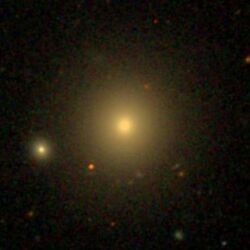Astronomy:NGC 3837
From HandWiki
Short description: Elliptical galaxy in the constellation Leo
| NGC 3837 | |
|---|---|
 SDSS image of NGC 3837. | |
| Observation data (J2000 epoch) | |
| Constellation | Leo |
| Right ascension | 11h 43m 56.4s[1] |
| Declination | 19° 53′ 40″[1] |
| Redshift | 0.020447[1] |
| Helio radial velocity | 6130 km/s[1] |
| Distance | 287 Mly (88.1 Mpc)[1] |
| Group or cluster | Leo Cluster |
| Apparent magnitude (V) | 14.25[1] |
| Characteristics | |
| Type | E[1] |
| Size | ~129,000 ly (39.4 kpc) (estimated)[1] |
| Apparent size (V) | 0.6 x 0.6[1] |
| Other designations | |
| ARAK 314, CGCG 97-89, MCG 3-30-68, PGC 36476, UGC 6701[1] | |
NGC 3837 is an elliptical galaxy located about 290 million light-years away[2] in the constellation Leo.[3] It was discovered by astronomer William Herschel on April 26, 1785.[4] NGC 3837 is a member of the Leo Cluster.[5][6][4]
See also
References
- ↑ 1.0 1.1 1.2 1.3 1.4 1.5 1.6 1.7 1.8 1.9 "NASA/IPAC Extragalactic Database". Results for NGC 3837. http://nedwww.ipac.caltech.edu/. Retrieved 2018-07-10.
- ↑ "Your NED Search Results". http://ned.ipac.caltech.edu/cgi-bin/objsearch?objname=NGC+3837&extend=no&hconst=73&omegam=0.27&omegav=0.73&corr_z=1&out_csys=Equatorial&out_equinox=J2000.0&obj_sort=RA+or+Longitude&of=pre_text&zv_breaker=30000.0&list_limit=5&img_stamp=YES.
- ↑ "Revised NGC Data for NGC 3837". http://spider.seds.org/ngc/revngcic.cgi?NGC3837.
- ↑ 4.0 4.1 "New General Catalog Objects: NGC 3800 - 3849" (in en-US). https://cseligman.com/text/atlas/ngc38.htm#3837.
- ↑ "Detailed Object Classifications". http://ned.ipac.caltech.edu/cgi-bin/NEDatt?objname=NGC+3837.
- ↑ "NGC 3837". http://simbad.u-strasbg.fr/simbad/sim-id?Ident=NGC++3837&NbIdent=query_hlinks&Coord=11+43+56.4178294753+19+53+40.408089496&parents=7&submit=parents&siblings=589&hlinksdisplay=h_all.
External links
- NGC 3837 on WikiSky: DSS2, SDSS, GALEX, IRAS, Hydrogen α, X-Ray, Astrophoto, Sky Map, Articles and images
 |

